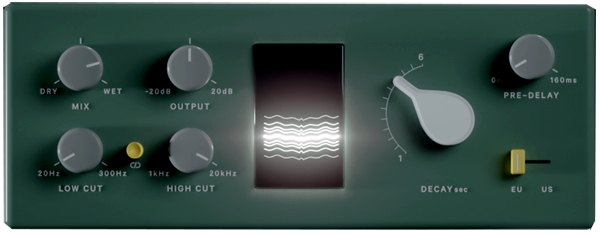|
|
Rare Signals' Transatlantic Plate Reverb
|
|
|
 |
| Rare Signals' Transatlantic Plate Reverb Plugin GUI |
Rare Signals' Transatlantic Plate Reverb is a new plugin that uses impulse responses from two, distinctly different reverb plates to emulate the bright, present sound of a traditional plate reverb unit. There is a switch on the GUI to select either "US", an Audichon aka "The Plate" made by (Nashville-based) Lawson Inc. in 1971.
Or switch to "EU" and get a vintage EMT 140ST plate formerly located at Bearsville Studio in Woodstock, NY. Both these plates were serviced and optimized and exceed the original units' specifications. The EU plate has six seconds of decay time--one second longer than the original EMT plate spec.
I installed Transatlantic Plate Reverb ver 1.3 into my antique, 2008 5,1 MAC Pro running Pro Tools HDX version 2020.12 on Mojave OS. Being an impulse response reverb, it works great but I have to be careful when using it as it requires a lot of CPU that I don't have on this old computer! So I asked a couple of producer/engineers to try out Transatlantic Plate Reverb using their more modern and powerful Mac computers. There is a free 7-day trial version at the Web site.
I like both plates for a lot for all the same reasons that, back in the day, I would reserve certain EMT plates when working at studios in Hollywood and elsewhere. I found a few magical ones but most were just OK and worked fine. I think there are two magical plate reverbs sampled in Rare Signals' Transatlantic Plate Reverb!
In the center of the GUI is a memorizing display that visual designer Ari Weinkle created as an artistic representation of the plate's movement--it shows wavy, fluid shapes depending on the source you're sending to it and the amount.
For a calypso piano part in a TV music mix, I went with the US plate. It is the brighter of the two and, when set short around the 1.5-second on the Decay control, it worked well to add a treble splash to the piano's sound not possible with just EQ.
The brightness of either plate can be dialed back using the onboard Low Cut (20Hz to 200Hz) and High Cut (1kHz to 20kHz) controls to carve and contour the reverb anyway you like to fit your use. I like the Link button that inversely links the low and high cut filters and controls. It is similar to a tilt equalizer: raise the low frequency setting, and the high frequency decreases. This makes for a quick and fast basic reverb setup.
For building huge reverberant backdrops, ambiences as if the back wall of your music's space, there is up to 130-ms of pre-delay available to either plate and I used this on a big string section.
Of the two, the EU plate is my favorite; its reverb seems to "melt" into and fill in the background with a smooth transparent lushness! It is not subtle but it also doesn't scream REVERB either! I liked it for vocals over the US plate for that reason. My crew of testing producer/engineers was unanimous loving the warmth, lushness and depth of the EU plate. We have all agreed that we will definitely be using both plates in the Transatlantic Reverb in every mix from now on.
Rare Signals Transatlantic Reverb sells for $149 MSRP download.
|
|
|